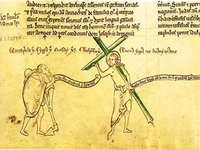SYNOPSES
WANDERING JEW, Doctor Eugene Sue (1845):
A melodrama with a strong message and colorful characters, whose strengths and weaknesses form an integral part of the story, is a work of tremendous television potential, providing high concept drama...a fascinating project as any major property to hit the screen today.
Story-line focuses on Joseph, the cobbler of Jerusalem...who mocked Christ on the day of His Crucifixion...the sinner who is condemned to wander undying throughout all of the centuries, all over the World; and Herodias, the Wandering Jewess, who demanded the head of Saint John the Baptist to be served on a platter, who is also condemned to live through centuries of sorrow.
The Jesuits, the masters of an intricate and diabolical conspiracy, plot to prevent the heirs from acquiring their money, fearing that their World-wide conspiracy to claim the legacy, now amounting to 212,175,000 francs, and their plan to govern the destiny of Europe, will be exposed.
In the end, the future goes up in smoke, but the long punishment suffered by the
CHRONICA MAJORA, Saint Albans Abbey (13th C)
THE JEW and THE JEWESS, Viereck & Eldridge (1930):
John the Evangelist is the original Cartaphilus, but he is soon absorbed by the true Wandering Jew, who was once Isaac, the Captain in the Army of Pontius Pilate. This Wandering Jew is seeking neither Christ nor Death, but sensation in sexual enjoyment:
"unendurable pleasure, indefinitely prolonged" ....
The continual and continuous love affairs in which the Wandering Jew indulges are all with the same woman, the Wandering Jewess, in whatever guise she may appear. Some of the historical figures encountered are Charlemagne, Columbus, Luther, Spinoza, Rousseau, and Frederick the Great...but others are more exotic personalities, such as Don Juan, Gilles du Retz, and near the end, Nietzsche.
PRINCE OF INDIA, General Lew Wallace (1893):
Both the title and locality chosen for this screenplay awaken the interests of the viewer. The PRINCE OF INDIA is the story of the Jewish shoemaker, condemned by our Lord to wander over the Earth until His Second Coming.
This "Wandering Jew" is first introduced at the hidden sarcophagus of Hiram, King of Tyre, which he has not visited for one thousand years. Ten centuries before, he had found this mine of priceless jewels, concealing the spot for his future exploration. He pays a short visit to Byzantium, where he possesses another treasure vault, and then departs for China for a stay of fifty years. It is after the expiration of this period he assumes the title of "Prince of India".
He is now filled with the purpose of teaching men that God is the Lord, under whatever form worshiped, and that all men should accept his teaching. Next, he goes to Constantinople to reveal this to the Greek Church, although he is at this time in league with the heir-apparent to the Turkish throne.
The "Prince of India", unsuccessful in his mission at Constantinople, and in rage and disappointment with the treatment he receives, sets fire to his possessions, fleeing to the side of Mohammed, who is heir to the Turkish Empire.
In many ways, this screenplay resembles BEN-HUR: it covers a period of many years, and its plot is built by putting together historical and geographical facts, and by weaving in a thread of romance. The second "boat race" introduced into this story suggests the famous "chariot race" in BEN-HUR. This property has value in awakening an interest in a fascinating period of history, and fixing in the mind of the viewer many historic events and customs, while its treatment of the religious questions involved is both broad and comprehensive.
Its pageantry, clash of cultures, effective set-piece scenes, pictorial realism, and narrative interest, all command the attention of the viewers; combination of larger-than-life characters, elaborate spectacles, and formalized dialogue, all seem to be made for the silver screen.
THE ABBEY, Walter Michael Miller Jr (1959):
In Fiat Homo ("Let there be Man"; in the year 2525, six hundred years after the Flame Deluge), relics of the founder of their Monastery, the Blessed Leibowitz, are discovered by chance in an ancient fall-out shelter by Brother Francis Gerard of Utah, a novice guided by the Pilgrim ("Wandering Jew" ), while he is fasting in the desert during Lent, and which are skillfully used by the Abbot of the Monastery to have the founder of its Order elevated to Sainthood. Sure of his religious life, Brother Francis returns back to the Abbey, informing the other novices of his experience, who improve and elaborate on his original story, until a rumor circulates that the young novice actually met, in the guise of the Pilgrim, the Blessed Leibowitz himself. Francis is immediately summoned into the office of Abbot Arkos to deny the rumors, which threaten to undermine the chance of the patron of the Abbey for Sainthood. Science is dormant, asleep in the archives garnered by the Abbey of the Blessed Leibowitz. Without any power instruments, the scale of warfare is intimate: bows and arrows, and laying siege.
In Fiat Lux ("Let there be Light"; A.D. 3174), the books so carefully preserved by the followers of Leibowitz are finally read by a man who is capable of making some sense of them, as a scientific civilization once again begins to develop, and North America takes steps toward reunification. Thon Taddeo is seen re-inventing basic concepts of electricity with the doubtful aid of the Leibowitzian Memorabilia. Electricity is rediscovered, and by this new illumination numerous agents of an ambitious Prince examine the Memorabilia, making secret sketches of the fortifications of their Abbey, in order to capture it, and exploit its buried knowledge. It deals with the development of a new Renaissance, and the shifting of power from the Church into yet another secular state.
In Fiat Voluntas Tua ("Thy Will be Done"; A.D. 3781), progress of science makes a deadly full-circle back to rockets, satellites, and nuclear weapons. The Abbot of "Sanly Bowitts" once again finds himself dealing with problems of radiation, civilian casualties, and euthanasia. As the bombs begin to fall, another generation escapes with its books and children... NLA

